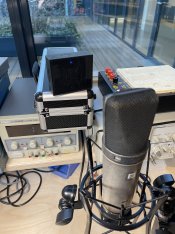Arbolito
Member
Hello everyone!
After countless reading in and out of these forums, here's my simple capsule replacement mod. T.bone SC450 (80€) with a replacement K67 capsule. As the t.bone microphone circuit is the same as MXL2001/V67 (whose first stage is same as u87), which already provides HF attenuation, it should sound quite close to the Neumann.
I scraped some paint from the t.bone microphone for a vintage look, and did a not very scientific comparison against a real Neumann u87 (very old one). The capsule inside purple circle is the new one, the other is the old one. I had to drill some holes in the microphone to fit the new one.
The audio files are Z and Y: does one sound better to you than the other on this source?
Y:View attachment micY.wav
View attachment micZ.wav
Z:
After countless reading in and out of these forums, here's my simple capsule replacement mod. T.bone SC450 (80€) with a replacement K67 capsule. As the t.bone microphone circuit is the same as MXL2001/V67 (whose first stage is same as u87), which already provides HF attenuation, it should sound quite close to the Neumann.
I scraped some paint from the t.bone microphone for a vintage look, and did a not very scientific comparison against a real Neumann u87 (very old one). The capsule inside purple circle is the new one, the other is the old one. I had to drill some holes in the microphone to fit the new one.
The audio files are Z and Y: does one sound better to you than the other on this source?
Y:View attachment micY.wav
View attachment micZ.wav
Z:
Attachments
Last edited:














